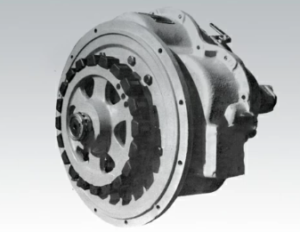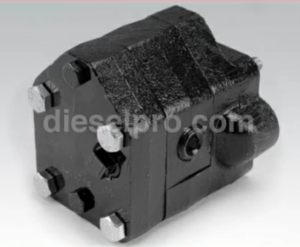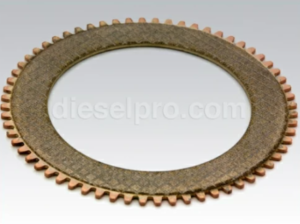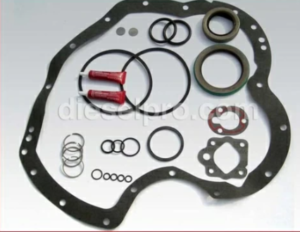
The Twin Disc MG507 Marine Gear is designed for reliability and durability, providing efficient and smooth transmission for various marine vessels. However, like all mechanical systems, it may encounter operational issues over time due to wear, environmental conditions, or improper maintenance. Identifying, diagnosing, and resolving these issues promptly is crucial to minimizing downtime and avoiding costly repairs.
This comprehensive guide will detail how to identify common problems, offer diagnostic tips and techniques, provide step-by-step solutions for frequent issues, and explain when it’s necessary to consult a professional for more complex problems.
Parts Catalog for Twin Disc MG507 Marine Transmissions
Rebuilt Twin Disc MG507 Marine Transmissions
Plate Kit For Twin Disc MG507 Marine Transmission
Gasket Kits For Twin Disc MG507 Marine Transmission
Identifying Common Operational Problems in Twin Disc MG507 Marine Gear
Understanding the signs of trouble is the first step in troubleshooting. The MG507 may exhibit various symptoms that indicate mechanical or hydraulic issues. Recognizing these early can prevent further damage.
1. Slipping Clutch
Symptoms:
- Engine RPM increases, but the vessel’s speed doesn’t correspond.
- Delayed or jerky engagement when shifting into gear.
- Burning smell during operation.
Possible Causes:
- Worn or damaged clutch plates.
- Insufficient hydraulic pressure.
- Contaminated or low hydraulic fluid.
- Incorrect clutch adjustment.
2. Hard or Delayed Shifting
Symptoms:
- Difficulty engaging forward or reverse.
- Noticeable delay when shifting gears.
- Grinding noises during gear engagement.
Possible Causes:
- Low or contaminated hydraulic fluid.
- Faulty hydraulic control valve.
- Misaligned coupling or propeller shaft.
- Worn or damaged clutch components.
3. Excessive Noise or Vibration
Symptoms:
- Grinding, whining, or knocking sounds during operation.
- Unusual vibrations in the engine room or through the vessel’s hull.
- Noise increases with load or speed.
Possible Causes:
- Misaligned coupling.
- Worn bearings or gears.
- Loose bolts or fasteners.
- Cavitation due to air in the hydraulic system.
4. Overheating
Symptoms:
- High oil temperature readings.
- Engine overheating during normal operations.
- Burning smell from the marine gear.
Possible Causes:
- Clogged or inefficient heat exchanger.
- Low oil levels or poor-quality oil.
- Inadequate cooling water supply.
- Blocked oil passages or restricted flow.
5. Hydraulic System Pressure Loss
Symptoms:
- Difficulty in clutch engagement.
- Poor gear shifting performance.
- Hydraulic fluid leaks.
Possible Causes:
- Low hydraulic fluid levels.
- Leaking hydraulic hoses or seals.
- Faulty hydraulic pump.
- Blocked hydraulic lines.
6. Oil Leaks
Symptoms:
- Visible oil puddles around the marine gear.
- Oil dripping from fittings or seals.
- Gradual decrease in oil levels without apparent usage.
Possible Causes:
- Damaged or worn seals and gaskets.
- Loose or damaged fittings.
- Overfilled oil levels.
- Cracked or worn gear housing.
Diagnostic Tips and Techniques for Twin Disc MG507 Marine Gear

Accurate diagnosis is key to solving operational issues. The following techniques will help identify the root cause of most MG507 problems.
1. Visual Inspection
- Check for Leaks: Inspect all hydraulic and oil lines, seals, and fittings for visible leaks.
- Look for Signs of Wear: Examine clutch plates, bearings, and gears for physical wear or damage.
- Inspect Oil Color and Smell: Dark or burnt-smelling oil may indicate overheating or contamination.
2. Use Diagnostic Tools

- Pressure Gauges: Monitor hydraulic and oil pressures to identify abnormalities.
- Thermal Imaging: Use a thermal camera to detect overheating in critical components.
- Vibration Analyzers: Identify irregular vibrations that could indicate misalignment or bearing failure.
- Dial Indicators: Measure shaft alignment and coupling balance.
3. Analyze Operational Data
- Oil Samples: Conduct regular oil analysis to detect contamination, metal particles, or water intrusion.
- Monitor Temperature Trends: Track oil and hydraulic fluid temperatures to spot gradual increases that could indicate cooling system issues.
4. Listen for Irregularities
- Pay close attention to any unusual noises during operation, such as grinding, clicking, or whining.
- Use a mechanic’s stethoscope to isolate sounds and pinpoint problem areas.
5. Check Maintenance Logs
- Review maintenance records to identify any patterns of recurring issues or recently replaced components that may contribute to the problem.
Step-by-Step Solutions for Common Issues in Twin Disc MG507 Marine Gear
This section provides detailed solutions for the most frequent issues encountered with the MG507. These step-by-step guides ensure effective troubleshooting and repair.
1. Resolving a Slipping Clutch

Step 1: Inspect Clutch Plates
- Remove the clutch housing cover and inspect the plates for wear, cracks, or burns.
- Replace any worn or damaged clutch plates.
Step 2: Check Hydraulic Pressure
- Connect a pressure gauge to the hydraulic system.
- Compare readings to the manufacturer’s specifications. If low, inspect for leaks or faulty pumps.
Step 3: Change Hydraulic Fluid
- Drain the old fluid, clean the system, and refill with high-quality hydraulic fluid.
- Bleed the system to remove air pockets.
Step 4: Test and Re-Adjust
- Test clutch engagement. If slippage persists, adjust the clutch engagement settings per manufacturer guidelines.
2. Fixing Hard or Delayed Shifting
Step 1: Inspect Hydraulic Lines
- Check for kinks, blockages, or leaks in the hydraulic lines.
- Replace damaged lines or seals.
Step 2: Flush Hydraulic System
- Drain the system and flush to remove any blockages or contaminants.
- Refill with fresh, recommended hydraulic fluid.
Step 3: Check Control Valve Operation
- Inspect the control valve for damage or debris.
- Clean or replace the valve if faulty.
Step 4: Re-Test and Inspect
- Re-engage the gear and observe for smoother shifting.
- If problems persist, inspect clutch assembly for further issues.
3. Solving Excessive Noise and Vibration
Step 1: Inspect Shaft Alignment
- Use a dial indicator to check for misalignment.
- Adjust and align the shaft as necessary.
Step 2: Check Bearings and Gears
- Inspect bearings for wear or damage. Replace any compromised components.
- Examine gear teeth for pitting or misalignment.
Step 3: Secure All Fasteners
- Tighten all bolts and fasteners to the correct torque specification.
- Check coupling bolts for tightness.
Step 4: Conduct Test Run
- Run the gear at low speed and gradually increase.
- Monitor for noise and vibration.
4. Addressing Overheating
Step 1: Inspect Heat Exchanger
- Remove and flush the heat exchanger to clear blockages.
- Replace if corrosion or damage is present.
Step 2: Check Oil Levels and Quality
- Top off or replace old oil with the correct marine-grade lubricant.
- Verify oil viscosity matches manufacturer recommendations.
Step 3: Inspect Cooling System Flow
- Check hoses and fittings for restrictions or leaks.
- Ensure adequate coolant flow throughout the system.
Step 4: Monitor Operating Temperatures
- After repairs, observe oil and system temperatures during a test run.
- Look for consistent cooling performance.
5. Repairing Hydraulic System Pressure Loss

Step 1: Identify Leaks
- Use dye tracers or visual inspection to detect leaks.
- Replace worn seals or damaged hoses.
Step 2: Test Hydraulic Pump
- Verify that the pump is generating sufficient pressure.
- Replace the pump if pressure is below the specified range.
Step 3: Clean Hydraulic Lines
- Flush the system to remove blockages.
- Replace filters and refill with fresh hydraulic fluid.
Step 4: Monitor Pressure Readings
- Retest the system to ensure stable and correct pressure levels.
6. Resolving Oil Leaks
Step 1: Identify Leak Source
- Clean the exterior of the marine gear and observe for new leaks.
- Focus on seals, gaskets, and fittings.
Step 2: Replace Faulty Seals
- Remove the damaged seals and install new, high-quality replacements.
- Apply sealant as needed to ensure a tight fit.
Step 3: Check and Tighten Fittings
- Tighten loose connections to manufacturer specifications.
- Replace worn or damaged fittings.
When to Consult a Professional
While many issues can be resolved through standard troubleshooting, certain complex or severe problems require professional intervention.
1. Repeated Hydraulic Failures
- If pressure problems persist after flushing and replacing components, consult a hydraulic specialist.
2. Severe Clutch Damage
- Extensive damage to clutch components or multiple clutch failures may require professional rebuilding.
3. Persistent Alignment Problems
- If alignment adjustments fail, a marine gear alignment

Parts Catalog for Twin Disc MG507 Marine Transmissions
Rebuilt Twin Disc MG507 Marine Transmissions
Plate Kit For Twin Disc MG507 Marine Transmission
Gasket Kits For Twin Disc MG507 Marine Transmission
Videos About Twin Disc Transmissions
6 Reasons Your Twin Disc Transmission Has Low Oil Pressure
7 Reasons Your Twin Disc Transmission Is Overheating
3 Reasons Your Clutch Plates in Your Twin Disc Transmission Are Making Excessive Noise
Bull Gear On A Twin Disc Transmission
Rebuilt Twin Disc Transmissions



 Free US Calls: 1-888-433-4735
Free US Calls: 1-888-433-4735 International: 305-545-5588
International: 305-545-5588